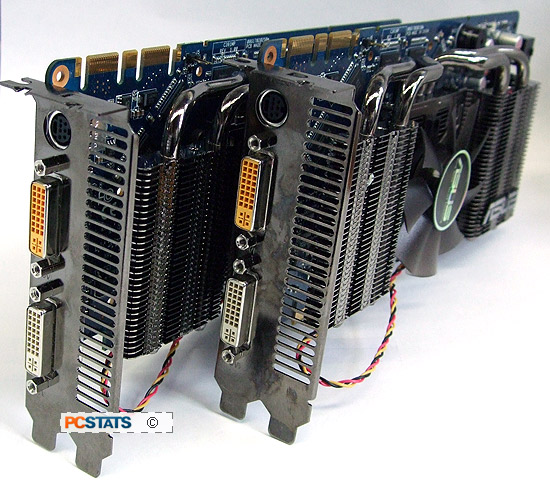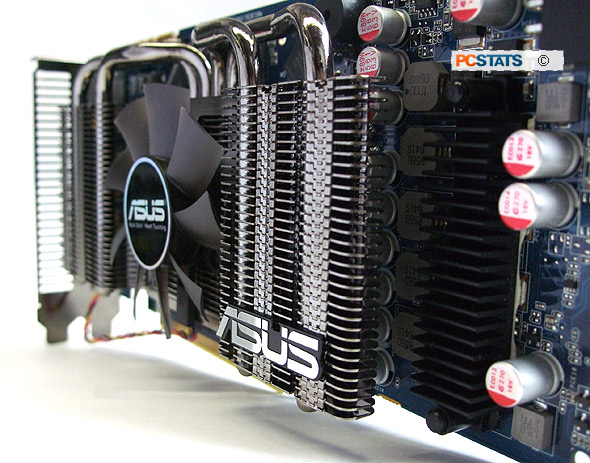In the final and most punishing of
PCSTATS benchmarking tests, Crysis at 1920x1200 with 8x anti-aliasing has the
ASUS ENGTS250 DK Geforce GTS 250 unable to cope in either single or SLI mode,
with a single Radeon HD 4850 being faster than either configuration.
Conclusions: Still Good
After All?

While there have been complaints that the name of the
videocard has changed more than the parts inside of it, after running through
the benchmark results for the ASUS ENGTS250 DK, it's clear that the nVidia
Geforce GTS 250 can still be a winner.
The Geforce G92 GPU has had time to mature since its first inception, with
decreases in its power consumption, heat production and overall physical size,
while at the same time gaining faster overall memory and clockspeeds. Despite
being several months older than AMD's RV770 GPU, the revisions to nVidia's G92
GPU have helped it stay competitive in the majority of today's benchmarks.
Asus has
complemented the G92 GPU with the design of its ENGTS250 DK videocard. The
customized cooler combines a high-airflow fan with copper heatpipes and
aluminium fins for improved overall cooling that was blissfully quiet on the
PCSTATS test bed.
When it came to the final performance throwdown between
the $200 CDN ($160 USD, £110 GBP) ASUS
ENGTS250 DK and the $200 Radeon HD 4850, both cards traded blows evenly, with
the Geforce GTS 250 winning out in most benchmarks until anisotropic and
anti-aliasing settings were turned up, and the Radeon sailed ahead of it.
SLI scaling continues to impress, with a pair of ASUS
ENGTS250 DK videocards rendering more frames per second than multi-GPU
videocards like the Radeon 4870 X2. This is largely due to nVidia's
tireless efforts with game developers and improving SLI profiles for Geforce
videocards, which have more consistent scaling performance than their AMD Radeon
counterparts. One of the best thing about this approach is that SLI
configurations tend to improve in performance over time, as nVidia releases more
efficient drivers.
Overclocking the ASUS ENGTS250 DK videocards produced
average results. Increasing the overall graphics core clock speed from 740MHz up
to 809MHz and the memory speed from 1100MHz to 1320MHz (effectively from 2200MHz
to 2640MHz) will definitely grant a few extra frames per second in demanding
games, but it's likely the G92 processor has already been pushed as far as it
will go.

While some might turn up their nose at the thought of
anything less than newly-architectured videocards, the Asus ENGTS250 DK
videocard shows that older GPUS can still keep up with the new kids, at least in
the mid-range market segment. The Geforce GTS 250 GTS is a solid videocard for
anyone who's looking to play DirectX 9 and 10 computer games at resolutions of
1680x1050, and a pair of GTS 250 videocards should be able to handle pretty much
any game on the market, provided anti-aliasing isn't turned up too high.

Find out about this and many other reviews by joining the Weekly PCstats.com Newsletter today!
Catch all of PCSTATS latest reviews right here.
Related Articles
Here are a few other articles that you
might enjoy as well...
- ASUS
EAH4890 HTDI/1GD5/A Radeon HD 4890 Videocard Review
- Gigabyte GV-N96TSL-1GI Geforce 9600GT Rev.B Videocard
Review
- ASUS
EAH4550 Radeon HD 4550 Half-Height Videocard Review
- MSI
R4830-T2D512-OC Radeon HD 4830 Videocard Review
- Asus
EAH4850 HTDI/512M/A Radeon HD 4850 Videocard Review
- ASUS
EAH3870 X2 Top/G/3DHTI/1G/A Radeon HD 3870 X2
Videocard
